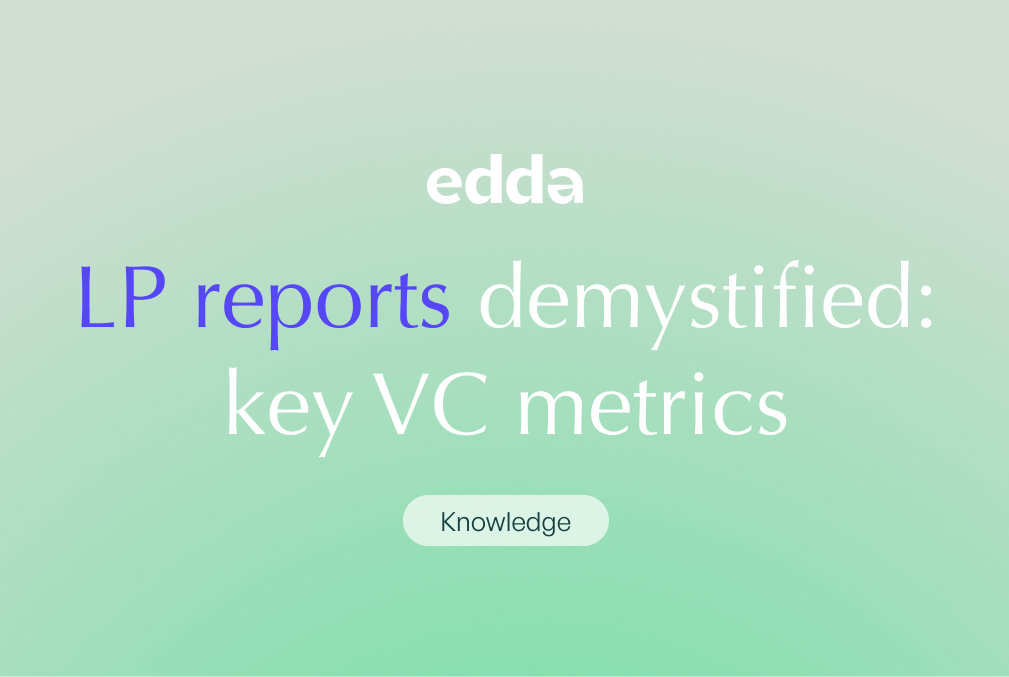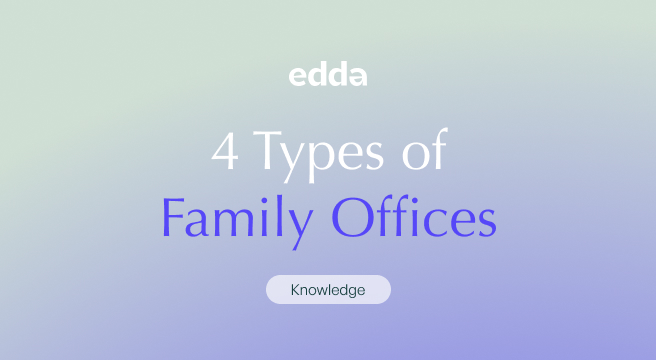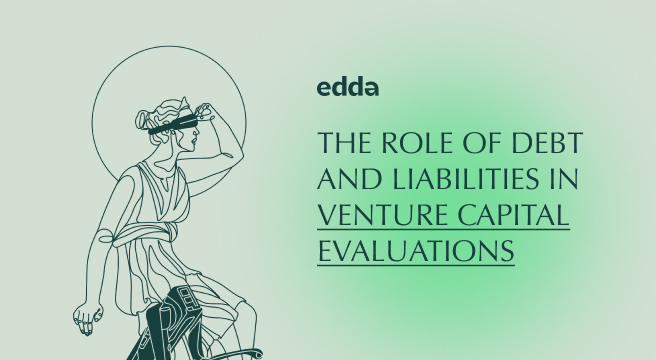Venture Capital (VC) investments, inherently high risk, and high reward in nature, require astute navigation and VC skills. A comprehensive understanding of LP reports becomes a compass for the Limited Partners (LPs) investing in these venture capital funds.
LP reports help maintain a transparent line of communication, fostering an environment of trust between Limited Partners and venture capital firms. They also serve as a window into the performance of the invested capital.
This article delves deeper into the metrics that typically inhabit LP reports, shining a light on the various aspects contributing to venture capital success. Furthermore, discover how Edda’s VC app can help streamline LP reporting processes.
Capital Calls and Distributions
The first critical juncture in understanding LP reports is recognizing capital calls and distributions. Capital calls, also referred to as drawdowns or takedowns, are requests made by VC firms for a portion, or all, of the committed funds by LPs. These funds are then allocated to portfolio companies as investments.
Distributions, in contrast, represent the returns that LPs garner from their investments. These returns may arise from successful exits of portfolio companies or regular revenue distributions.
Investor’s Perspective: LPs view these as immediate indicators of the fund’s operational dynamics. They assess the frequency and magnitude of capital calls to understand the fund’s cash needs and investment pace. High and frequent capital calls might indicate active investments, while lower and infrequent ones may suggest a more cautious approach. Similarly, regular distributions reflect the fund’s ability to generate returns, influencing LPs’ confidence in the fund’s performance.
Committed Capital
Committed Capital represents the total amount an LP has pledged to invest in a venture capital fund over its lifetime. It forms the foundation of a VC fund’s operations, offering a snapshot of the fund’s potential scale and the ceiling of its investment capability.
Investor’s Perspective: This metric assists in planning future financial obligations, given it’s the total amount an LP has pledged to invest. Changes in Committed Capital can also signal shifts in the fund’s strategy or focus, and simultaneously act as a barometer of overall market confidence. In essence, Committed Capital serves as a vital guidepost in an LP’s decision-making process, financial planning, and market sentiment analysis.
Invested Capital
Invested Capital signifies the part of the committed capital that has been utilized for investments in portfolio companies.
Investor’s Perspective: Invested Capital serves as a crucial metric for LPs as it provides insights into the fund’s pacing and investment strategies. This metric shows how swiftly and effectively the VC firm is deploying committed capital into high-potential companies. Rapid deployment might suggest an aggressive strategy or favorable market conditions, whereas slower deployment might imply a more cautious approach. Thus, invested capital allows LPs to gauge the fund’s operational efficiency and risk profile, guiding them in assessing the fund’s management prowess and potential alignment with their investment goals.
Net Asset Value (NAV)
Net Asset Value (NAV) serves as a yardstick of the current worth of a fund’s holdings. It involves tallying up the value of all portfolio holdings and cash, subtracting any liabilities, and dividing the result by the total number of outstanding shares in the fund.
Formula: (Total value of portfolio holdings + Cash) – Liabilities
Investor’s Perspective: The Net Asset Value (NAV) is a crucial metric as it directly reflects the current value of their share in the fund. NAV offers an estimate of what LPs could potentially receive if all investments were liquidated at their current market values. Fluctuations in NAV could signal the overall health and performance of the fund’s investments. Therefore, LPs closely monitor the NAV to assess how their investment is faring and to make informed decisions about their continued participation or potential exit from the fund.
Internal Rate of Return (IRR)
IRR is a pivotal metric present in LP reports. It measures the annualized effective compounded return rate that can be earned on the invested capital. A fund with a higher IRR is usually seen as more successful as it promises a higher return.
Formula: Σ(Cash Flow_t / (1 + IRR)^t) = 0, where Cash Flow_t represents the net cash flow at time t
Investor’s Perspective: The Internal Rate of Return (IRR) serves as a vital benchmark for comparing the performance of various funds and making investment decisions. A higher IRR indicates a more successful fund, projecting potentially higher returns on their invested capital. However, LPs also understand that IRR is a projection and may not accurately capture the ultimate return, especially when future market conditions are unpredictable. Thus, while IRR is an important factor in making investment decisions, it is considered alongside other metrics and broader market trends to paint a more holistic picture of the fund’s performance and potential returns.
Total Value to Paid-In Capital (TVPI)
TVPI measures the total value returned or expected to be returned by the fund. This is computed by adding distributions and the NAV and dividing this sum by the total amount of invested capital.
Formula: (Distributions + NAV) / Total Invested Capital
Investor’s Perspective: Total Value to Paid-In Capital (TVPI) is a critical measure of the fund’s overall performance. It encapsulates both the realized returns (distributions) and the unrealized potential (NAV). LPs examine the TVPI metric closely to assess the total value they can expect from the fund relative to their investment. A TVPI greater than 1.0x is a positive sign, indicating that the fund is expected to return more than the invested capital, pointing to a successful investment. However, LPs also understand that the TVPI includes both actual distributions and unrealized value, requiring careful assessment of the portfolio’s potential to realize the value embedded in the NAV.
Distributions to Paid-In Capital (DPI)
DPI is a crucial indicator of the return of investment to LPs. It’s calculated by dividing the total amount of distributions by the amount of invested capital.
Formula: Total Distributions / Total Invested Capital
Investor’s Perspective: Distributions to Paid-In Capital (DPI) is a significant metric as it directly reflects the return of investment they have received so far from the fund. A high DPI implies a high return, and therefore, a successful investment. This tangible return often gives LPs the confidence to continue investing in the fund or consider future commitments. However, it’s also important for LPs to balance this with the potential for future returns, particularly in cases where a fund’s DPI may be lower due to significant unrealized value in the portfolio.
Residual Value to Paid-In Capital (RVPI)
RVPI measures the portion of the fund’s value still invested in portfolio companies. It’s calculated by dividing the NAV by the total amount of invested capital.
Formula: NAV / Total Invested Capital
Investor’s Perspective: The Residual Value to Paid-In Capital (RVPI) can serve as an indicator of unrealized returns or future profit potential. A high RVPI might indicate a significant upside potential, suggesting that many investments could still mature and yield significant returns. However, it also adds a layer of uncertainty as these are unrealized gains, and the final return may vary based on market conditions, company performance, and exit opportunities. Thus, LPs generally consider RVPI along with other metrics like DPI and TVPI to get a holistic view of the fund’s performance and potential return on investment.
Vintage Year
Vintage Year refers to the year in which the first influx of investment from a fund was made. Comparing funds of the same vintage year helps to compare performance on a like-for-like basis, accounting for differing market conditions in different years.
Investor’s Perspective: This parameter helps LPs in understanding how a specific fund performs relative to its peers that began investing in the same time frame. Therefore, the vintage year is vital in portfolio diversification, risk management, and investment strategy formulation. It also aids in understanding market cycles and trends, helping LPs make data-driven investment decisions.
Fund Multiples
Fund Multiples, specifically the Paid-In Multiple and the Distributed Multiple, form the cornerstone of LP reports. The Paid-In Multiple refers to the ratio of total capital drawn to committed capital, while the Distributed Multiple relates to the total distributed returns to the drawn capital.
Paid-In Multiple: Total Capital Drawn / Committed Capital
Distributed Multiple: Total Distributed Returns / Total Capital Drawn
Investor’s Perspective: The Paid-In Multiple offers insight into how aggressively the fund is deploying its committed capital, indicating the fund’s investment pacing and risk appetite. On the other hand, the Distributed Multiple provides a direct measure of realized returns against the drawn capital, demonstrating the fund’s ability to generate profitable exits. Together, these metrics allow LPs to evaluate their investments’ performance, the fund’s cash management efficiency, and to make informed decisions about future commitments or reallocations.
Empowering Transparency and Trust through Simplified LP Reporting
LP reports are the linchpin of transparency and trust between LPs and venture capital firms, providing LPs with a clear view of their capital’s deployment and performance.
Modern solutions to manage VC deal flow, such as Edda’s venture capital portfolio management tool, are designed to streamline and simplify the LP reporting process. Edda (formerly Kushim) provides an easy-to-use platform to track these key metrics, making it more efficient for LPs to monitor their VC investments and for VC firms to communicate their performance.
By unveiling the intricacies of these key metrics, we hope to empower LPs and VC firms alike with the knowledge to navigate the venture capital landscape, fostering an environment of informed decision-making, transparency, and mutual success. Contact us to schedule a demo of our venture capital management software today.



